Bulletin – September 2010 Economic Change in India
- Download the article 184KB
Abstract
India has become an increasingly important part of the global economic landscape over the past decade. Its economy has become more open to international trade, its workforce is growing strongly and the rate of investment has picked up following economic reforms. The strong growth of the Indian economy has also seen a significant deepening of the trade relationship between Australia and India, with India now the third largest destination for Australia's exports.
Introduction
This article discusses developments in the Indian economy over the past decade and the increasing importance of India as a trading partner for Australia. It pays particular attention to the evolving industrial structure of the Indian economy as well as recent trends in investment and international trade. The article also examines the nature of India's trade, with a particular focus on its trade with Australia.
Economic Developments in India
Over the past decade, growth in India increased after a number of decades in which growth was lower than typical of an economy at its stage of development. Since 2000, growth has averaged around 7 per cent per year, up from an annual average of 4½ per cent over the previous four decades (Graph 1). In part, this improvement reflects a series of economic reforms that have significantly opened up the economy and encouraged investment. As a result, on a purchasing power parity (PPP) basis, India's economy is now the fourth largest in the world, accounting for nearly 5 per cent of global GDP (Graph 2).
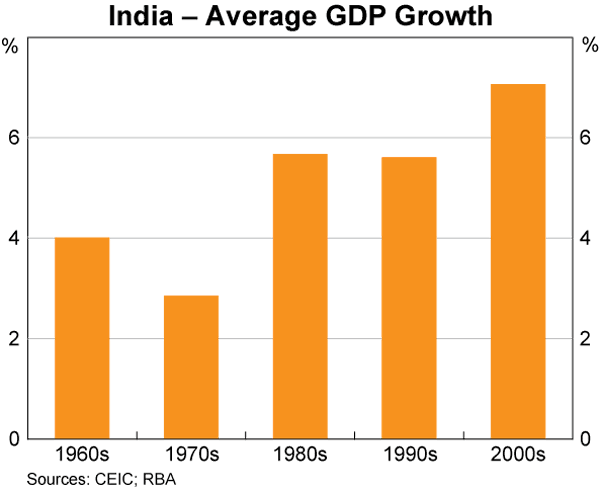
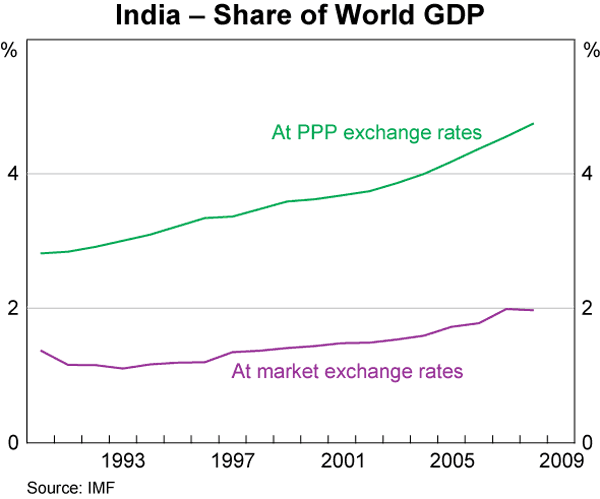
The structure of the Indian economy differs in some important respects from that of most other developing economies. In particular, the services sector of the economy is larger than in other countries with similar levels of per capita income. India's industrialisation has occurred more gradually, with much of the decline in agriculture's share of GDP being absorbed by the services sector (Graph 3). As discussed below, this is mainly due to the fact that manufacturing investment historically has been closely regulated. In contrast, the services sector has been subject to less regulation.
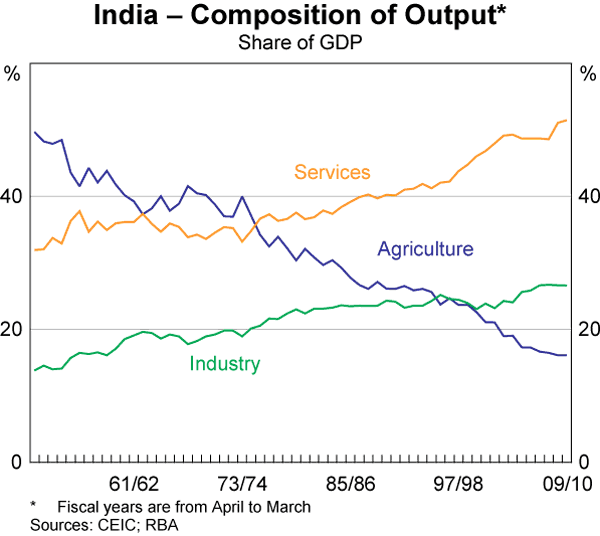
India's demographic outlook is also somewhat different from some other Asian countries. India's population is expected to grow over the coming decades, while the size of the population of most of its east Asian neighbours is expected to begin to fall at some point. Projections from the United Nations suggest that India will become the most populous country in the world in the next 20 years. Furthermore, India's long-term economic growth is likely to benefit from a working-age population that is expected to grow until at least the middle of this century, unlike countries such as Japan, South Korea and China (for details see RBA (2010) and Hall and Stone (2010)).
Investment in India
The investment share of GDP in India has historically been low but has increased significantly over the past 10 years. The earlier slow rate of capital accumulation contributed to the low rates of growth in per capita income in India between the 1960s and the 1980s. However, the rate of growth in investment has increased over the past decade and the investment share in India is now at a level that is consistent with those that prevailed in South Korea and China when these countries were at a similar stage of development (Graph 4).
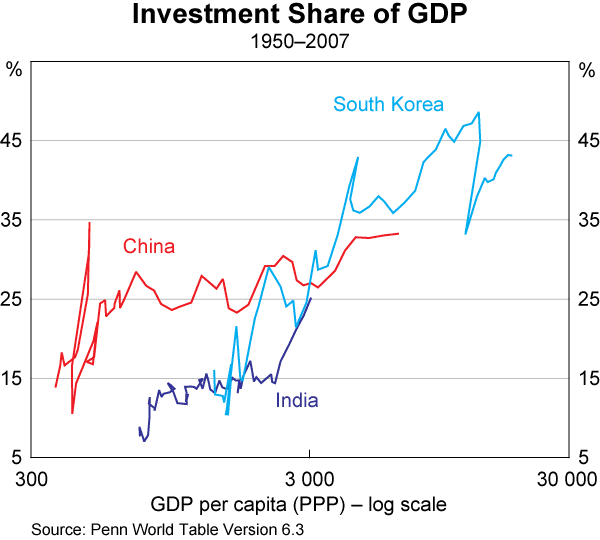
The historically low investment share and India's earlier lacklustre economic performance partly reflected the highly regulated nature of the Indian economy. Throughout the 1960s and 1970s, there were strict controls on investment, the public sector had a very large presence in most industries, and private industries were tightly restricted under a licensing regime that limited product differentiation and decisions on investment, output and employment.
These restrictions were particularly stringent in the manufacturing sector. In 1967, India introduced its small-scale industries (SSI) reservation policy whereby large-scale investment projects were heavily restricted. Under the reservation policy, only those companies below a certain size were given permission to produce items that were on the SSI list. Large-scale manufacturers of labour-intensive goods were significantly restricted in their investment activities under this regime. By the end of the 1970s, as many as 1000 items were included on the SSI reservation list.[1] These policies acted to create a more fragmented manufacturing sector and reduced its competitiveness by restricting the ability of firms to take advantage of increasing returns to scale.
Throughout the 1980s, various market-based reforms were gradually introduced and applied to a narrow set of industries. The limits on investments requiring industrial licenses were raised, as was the asset level at which firms were allowed to produce items on the SSI list. Import controls were also lifted on various products, including raw materials and other intermediate inputs, and various export incentives were introduced. However, significant restrictions and government control of industry and trade remained in place.
In 1991, a balance of payments crisis resulted in a sharp slowing of the Indian economy, prompting a more comprehensive set of market-based reforms under a new industrial policy.[2] The reform plan virtually abolished the industrial licensing regime and some government-owned firms were privatised. Anti-competitive restrictions on firm-entry in various industries were also abolished gradually throughout the 1990s.
De-reservation of products on the SSI list, which began at a very gradual pace between
1997 and 2001, accelerated rapidly in the
2000s.[3]
The smaller set of restrictions faced by the producers of newly de-reserved products
and increased flows of foreign investment led to a sharp rise in investment
by the manufacturing sector. Investment in machinery and equipment and construction
contributed significantly to the pick-up in investment growth (Graph 5).
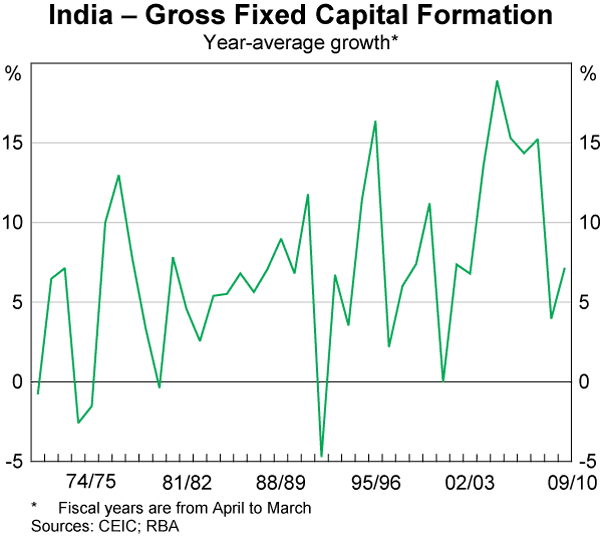
India's International Openness
The Indian economy has also become more open over the past 20 years. Through the 1980s, both the import and export shares of GDP were below 10 per cent, reflecting many restrictions that limited the capacity of firms to engage in international trade (Graph 6). The reforms of the 1990s lifted many of these restrictions; some exchange rate controls were abolished, tariffs were reduced and restrictive import licensing on most capital and intermediate goods was eliminated. As a result, by the mid 2000s, both the import and export shares had increased to around 15 per cent of GDP. Additional reforms between 2004 and 2008, including cuts to tariffs, resulted in a rapid further expansion of international trade with the import and export shares of GDP increasing by 2009 to levels similar to those for Australia.
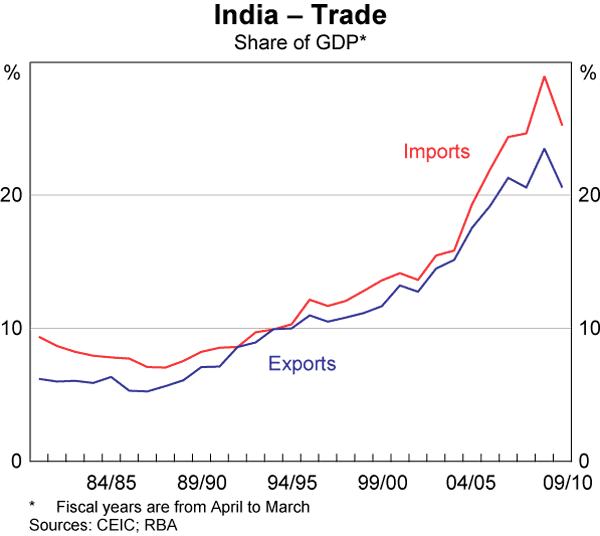
The growth in investment during the 2000s discussed above was partly due to the increase in foreign direct investment (FDI) inflows from around ½ per cent of GDP to above 2 per cent of GDP in a very short period of time (Graph 7). Government processes to approve foreign investment were simplified and restrictions on foreign investment relaxed.
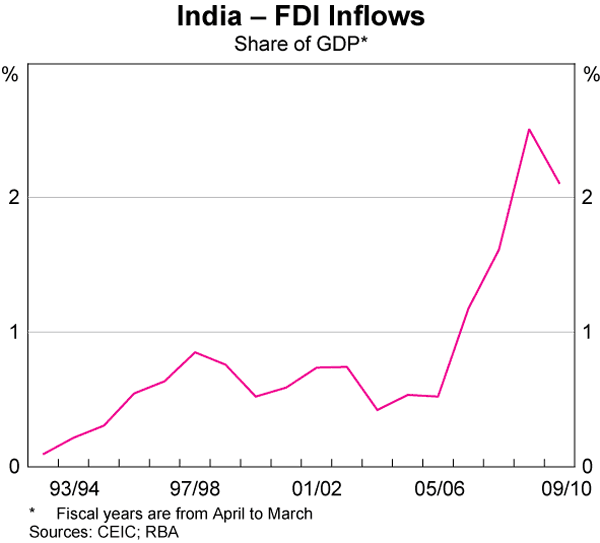
The Composition of Indian Trade
As its economy has become more open, India has become an important trading partner for many countries, with its share of world trade tripling over the past 20 years to 1½ per cent.
India's largest merchandise export is processed petroleum products (e.g. lubricants, kerosene and propane; Table 1). India has the world's fifth largest oil refining capacity and is a large importer of crude oil. This helps to explain its significant trading relationship with the United Arab Emirates, India's largest trading partner, which is also a major importer of India's processed petroleum products. Despite its vast iron ore deposits, India's iron ore exports are a small share of its total exports, partly reflecting export duties applied to iron ore and designed to promote growth in its steel sector. The high value of India's imports of gold also reflects India's status as the world's largest consumer of gold, while India is also a significant importer and exporter of precious and semi-precious stones, some of which are typically processed and re-exported to countries such as the United States, the United Arab Emirates, and Australia.
| Exports | Imports | ||
|---|---|---|---|
| Processed petroleum products | 23.2 | Petroleum oil (crude) | 64.9 |
| Pearls and precious or semi-precious stones |
17.0 | Non-monetary gold |
23.4 |
| Gold, silverware, jewellery |
13.6 | Pearls and precious or semi-precious stones |
15.4 |
| Iron ore | 5.3 | Telecommunications and sound equipment | 11.6 |
| Total | 176.8 | Total | 266.4 |
|
Source: UN Comtrade |
|||
India's trade in services is also significant. Services account for around 30 per cent of India's total exports, but only 10 per cent of its imports. Software services, which only accounted for 20 per cent of India's services exports in the late 1990s, are now more than half of India's services exports.
While much attention has been paid to the fact that China has become Australia's largest trading partner, less attention has been paid to the fact that India has also become an important destination for Australia's exports. In 2009, India ranked as Australia's third largest export destination from being fifteenth in 1999, surpassing Australia's more traditional destinations such as the United Kingdom and the United States. Australia recorded a trade surplus with India of A$15.5 billion in 2009, second only to the trade surplus recorded with Japan.
Australia's top three exports to India account for over 80 per cent of exports
to India (Table 2). One-third of the value of Australia's exports
to India is accounted for by trade in gold. Coal (mainly metallurgical) and
education-related travel are also major exports to India. Australians travelling
to India and imports of electrical parts are Australia's largest imports
from India. Despite general perceptions, imports of information technology
services account for less than 10 per cent of Australia's imports from
India.
| Exports to India | Imports from India | ||
|---|---|---|---|
| Non-monetary gold | 6,715 | Personal travel | 392 |
| Coal | 5,006 | Rotating electrical plant & parts | 341 |
| Education related travel | 3,187 | Information technology | 139 |
| Copper ores and concentrates | 826 | Pearls and gems | 124 |
| Total | 18,185 | Total | 2,697 |
|
Source: ABS |
|||
Conclusion
The Indian economy has grown strongly over the past 10 years. It has been opened up to foreign trade and inflows of foreign direct investment have increased significantly, its labour force is growing relatively quickly and is expected to continue growing over the coming decades, and the rate of investment has increased considerably. Partly as a result of these developments, prospects for growth over coming years have improved noticeably, although significant challenges lie ahead, particularly in providing the necessary infrastructure to support the expansion of the private sector and increasing urbanisation. Strong growth in India is also likely to see a deepening of the bilateral trade relationship between Australia and India.
Footnotes
The authors are from Economic Group. [*]
For a further explanation of the SSI reservation policy, and various reforms in this area, see Balasubrahmanya (1995), Panagariya (2008) and National Productivity Council (2009). [1]
For an analysis of the 1990s reforms, see Ahluwalia (2002), Srinivasan (2003), Panagariya (2004, 2008) and Mohan (2006). [2]
See National Productivity Council (2009). [3]
References
Ahluwalia MS (2002), ‘Economic Reforms in India Since 1991: Has Gradualism Worked?’, Journal of Economic Perspectives, 16 (3), pp 67–88.
Balasubrahmanya MH (1995), ‘Reservation Policy for Small-Scale Industry: Has It Delivered the Goods?’, Economic and Political Weekly, 30 (21), pp M51–M54.
Hall J and A Stone (2010), ‘Demography and Growth’, RBA Bulletin, June 2010, pp 15–23.
Mohan R (2006), ‘Economic Reforms in India: Where are We and Where Do We Go?’, Institute of South Asia Studies, Singapore, 10 November.
National Productivity Council (2009), Impact of Dereservation on SSI Sector, Economic Services Group, National Productivity Council, New Delhi.
Panagariya A (2004), ‘Growth and Reforms during the 1980s and 1990s’, Economic and Political Weekly, 39(25), pp 2581–2594.
Panagariya A (2008), India: The Emerging Giant, Oxford University Press, New York.
RBA (Reserve Bank of Australia) (2010), ‘Box B: The Growing Importance of the Indian Economy’, Statement on Monetary Policy, February, pp 13–14.
Srinivasan TN (2003), ‘Indian Economic Reforms: A Stocktaking’, Stanford Institute for Economic Policy Research, SCID Working Paper 190.